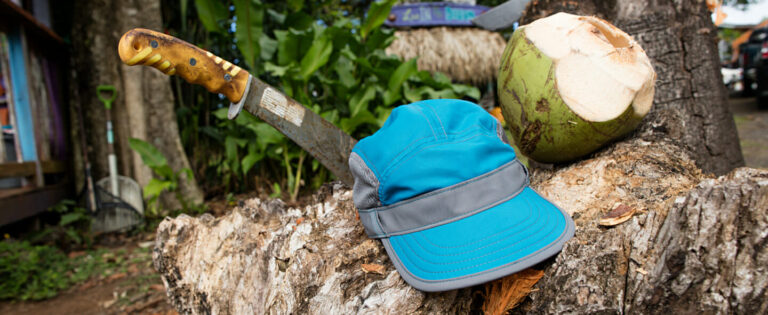
As we all know, the summer is our main thunderstorm season, so there’s always a risk of a storm when camping in the summertime. Near the end of a hot and humid summer day, you’ll often run into extremely violent thunderstorms, complete with strong rains, winds and hail. Thus, it’s incredibly important to find a spot that will not only provide the protection you need from strong winds and lightning but one that will prevent rainwater from pooling and has optimal pegging conditions. Even though most of us immediately think of the risk of getting struck by lightning, the risk of our tent getting destroyed by the storm or flooded by the rain shouldn’t be underestimated.
All too often, trekkers and campers poorly select their pitches, putting themselves in harm’s way and allowing their tent to be transformed into a little pool that nobody wants to swim in! As for the risk of getting struck by lightning, it is indeed very low, but you can reduce it to an absolute minimum by being prudent and adaptive.
The pitch, not the tent, will protect you from the storm

Unfortunately, a tent is not a Faraday cage, like a car, which can transfer the enormous current of 20,000 amp from the surface to the ground. Instead, you’re just as well or poorly protected from a thunderstorm inside a tent as you would be without one. For this reason, there are two things that you absolutely have to keep in mind when camping out in the open. For one, when selecting a pitch, you always need to consider the possibility of a storm because it is very difficult, and often even impossible, to move camp when a storm is nearby. The other factor is the action you take when a storm is coming. You may not be able to find the best pitch for your tent, so you’ll be forced to asses the situation and make a quick, but very good decision.
Choosing your campsite to reduce the risks during a storm
When selecting your pitch, you need to keep three crucial factors in mind:
The dangers of lightning
Lightning often strikes tall, exposed locations, meaning that tall trees or groups of trees, small hills or knolls in an open area or exposed locations in the mountains are particularly risky. The risk of getting struck by lightning in the forest is much lower.
The dangers of strong storm winds
A pitch that is exposed to wind increases the risk of your tent getting damaged by the storm. However, those typical areas we all think will provide protection, such as those covered by trees, need to be carefully inspected. For example, if you set up camp near trees, there’s always a risk of the branches breaking off and falling on your tent or even trees being completely uprooted over the course of a storm. You should also watch out for flying objects that could very easily damage the walls of your tent. Secure anchors in the ground consisting of quality pegs and taut guy lines will prevent your tent from getting torn or flung up in the storm. If you know the direction of the region’s prevailing winds, you should pitch your tent so that it offers as little wind resistance as possible. If possible, the entrance to the tent should be facing away from the prevailing wind.
The dangers of heavy rains
The large amount of water that can accumulate during a short storm is the biggest risk for tents and can cause even more damage than lightning itself. In hollows, tents are submerged from below, whilst in dried-out streambeds, you can run into torrents of water. Rivers can rise and flood the area. This is reinforced by the fact that sluice gates are opened upstream due to heavy rains and the amount of water in a valley drastically increases. Due to the large amounts of water, it is also extremely dangerous near rock faces, as individual rocks can fall from a cliff face, resulting in even larger quantities of rock falling. In the worst case scenario, this could result in a landslide or a debris avalanche. In sum, it’s very important to determine where the water could come from and where it will flow to.
Determining your distance from the storm
When a storm’s approaching, the distance of the thunderclouds is a crucial factor in judging your own personal safety. To calculate the distance correctly, you can use our calculator for determining the distance of a storm and other useful tips.
Your storm action plan
If the storm is too close or has basically already arrived, it might be a good idea to forget about pitching your tent and instead seek refuge under a ledge, in a hut or a cave. Since all metal objects can attract lightning, it is also advisable to store these some distance away in waterproof containers.
If you’re inside your tent, be sure to crouch down and make yourself small on an insulated surface. It is best to leave your walking boots on and crouch down on a double-folded sleeping mat or your walking backpack without placing your hands on the ground for support. It is also important that there is no standing water on the interior of the tent, as water is an excellent conductor of electricity. If you’ve chosen your pitch well and lightning happens to strike really close by, you should be able to keep yourself safe with the help of insulation to protect yourself from ground currents and by making yourself small.
Information is key
It’s not always possible to avoid running into storms on camping trips. Pitching your tent in a good spot and taking the proper action can indeed reduce the risks associated with thunderstorms, but it is just as important to have a look at the weather situation before heading out on your adventure. If it’s possible to simply avoid a storm in an open area or in the mountains all together, then that’s certainly your best option. Summer thunderstorms tend to occur in the afternoon, so weather services and weather apps are often able to detect them. So, use these services! You’ll be able to plan your trip well and find the perfect pitch!




